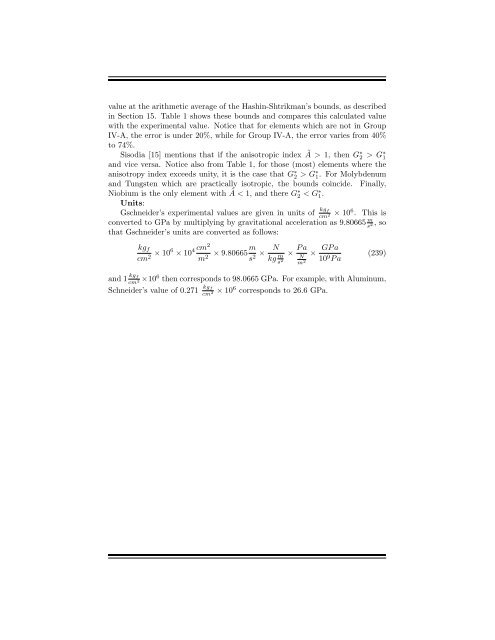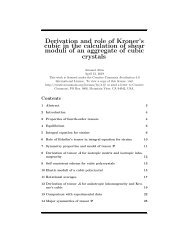Create successful ePaper yourself
Turn your PDF publications into a flip-book with our unique Google optimized e-Paper software.
value at the arithmetic average of the Hashin-Shtrikman’s bounds, as described<br />
in Section 15. Table 1 shows these bounds and compares this calculated value<br />
with the experimental value. Notice that for elements which are not in Group<br />
IV-A, the error is under 20%, while for Group IV-A, the error varies from 40%<br />
to 74%.<br />
Sisodia [15] mentions that if the anisotropic index à > 1, then G∗ 2 > G ∗ 1<br />
and vice versa. Notice also from Table 1, for those (most) elements where the<br />
anisotropy index exceeds unity, it is the case that G ∗ 2 > G ∗ 1. For Molybdenum<br />
and Tungsten which are practically isotropic, the bounds coincide. Finally,<br />
Niobium is the only element with à < 1, and there G∗ 2 < G ∗ 1.<br />
Units:<br />
kg f<br />
cm 2<br />
Gschneider’s experimental values are given in units of × 10 6 . This is<br />
converted to GPa by multiplying by gravitational acceleration as 9.80665 m s<br />
, so 2<br />
that Gschneider’s units are converted as follows:<br />
kg f<br />
cm 2 × 106 × 10 4 cm2<br />
m 2 × 9.80665 m s 2 × N<br />
kg m s 2<br />
× P a<br />
N<br />
m 2<br />
× GP a<br />
10 9 P a<br />
(239)<br />
and 1 kg f<br />
cm<br />
×10 6 then corresponds to 98.0665 GPa. For example, with Aluminum,<br />
2<br />
Schneider’s value of 0.271 kg f<br />
cm<br />
× 10 6 corresponds to 26.6 GPa.<br />
2



